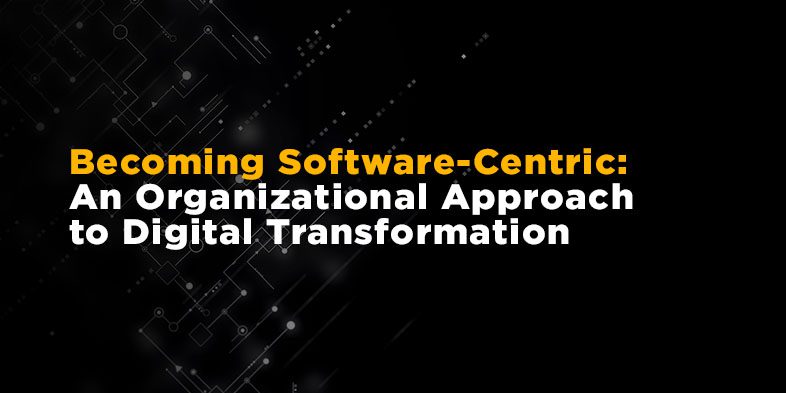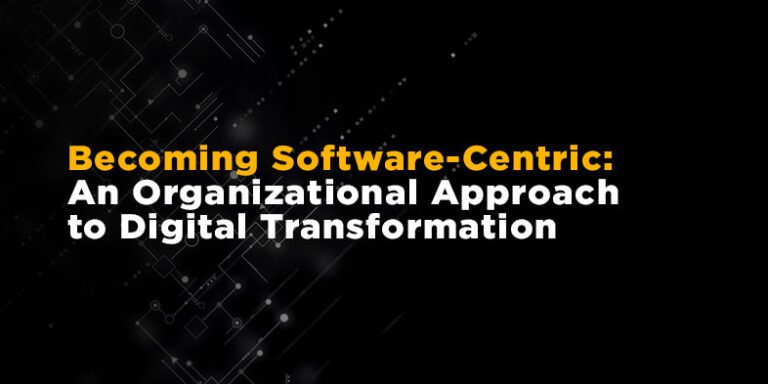Becoming Software-Centric: An Organizational Approach to Digital Transformation


As part of Solutions Review’s Contributed Content Series—a collection of contributed articles written by our enterprise tech thought leader community—Jiani Zhang, the Executive Vice President and Chief Software Officer at Capgemini Engineering, outlines a software-centric, organizational approach to digital transformation.
 For several years, the business and technology landscape has been inching closer to becoming a digital-first economy, with enterprises across industries putting software at the heart of their business models. This new digital era has made software adoption an imperative and has challenged many organizations to ask themselves, “What does it mean to be a software company?”
For several years, the business and technology landscape has been inching closer to becoming a digital-first economy, with enterprises across industries putting software at the heart of their business models. This new digital era has made software adoption an imperative and has challenged many organizations to ask themselves, “What does it mean to be a software company?”
The ongoing software-driven transformation organizations are facing will define the future of almost every industry. In fact, new research confirms that one-quarter of organizations already consider themselves software companies, with an additional 32 percent reporting that they expect to do so within the next three to five years. As these enterprises transform themselves into software companies, they must reconstruct their business models around software and, in doing so, change their revenue models, business processes, and organizational structures.
Revenue Models
On average, organizations invest 18 percent of their R&D budget in software initiatives, which is expected to continue rising. This growing investment has impacted the revenue models of enterprises in crucial ways, a trend that will continue for years to come. To increase software and digital revenue, businesses must transform customer contracts and payment methods. This will involve integrating and scaling leasing, micro-payments, on-demand, and subscription models to utilize software-based capabilities and features.
However, these enterprises will ultimately reap the benefits by unlocking new revenue streams and experiencing significant cost reductions. In fact, 90 percent of automotive organizations have generated new revenue streams by deploying software-driven products and services. In comparison, 59 percent of industrial and capital goods companies have reduced costs by implementing a successful software transformation strategy.
What’s more, low-cost airline EasyJet is investing in new aircraft software from Airbus that is designed to cut costs on jet fuel. By implementing this new capability, the airline will save more than 98,000 kg of fuel per year per aircraft across its European network.
Business Architecture
Preparing your organization for a software transformation requires leadership to reevaluate the entire business architecture. New software-centric initiatives must be scalable and can interact with other systems across the company, such as communication channels, software stacks, computing infrastructure, hardware platforms, analytics, and beyond.
Due to this complexity, enterprises must build a centralized architecture that can be specialized to the unique needs of individual business teams. This architecture must be standardized, flexible, and, most importantly, scalable. When selecting a business architecture, leaders should ensure a clearly defined roadmap, as the implications of this choice are far-reaching and long-lasting.
Leaders should consider several key factors when selecting a business architecture:
- Design with common standards and solutions: Organizations should select a system design that adheres to widely followed standards, as custom solutions increase uncertainty.
- Flexibility and scalability: Organizations should select a software solution that offers flexibility and interoperability across platforms (i.e., cloud, edge, on-prem). These solutions should be future-proofed and equipped to adopt new features.
- Modularity: Organizations should select a modular design that successfully facilitates upgrades and troubleshooting and supports multiple design roadmaps while avoiding overly modular designs that increase complexity.
- Accessibility and reliability: Organizations should select architecture proven to be reliable with solid uptime.
Finally, organizations on this journey cannot forget the importance of sustainability. Only 28 percent of organizations are currently measuring the environmental impact of their software development. Enterprises must prioritize long-term energy efficiency and environmental protection to ensure a sustainable software transformation. Their selected architecture should meet expected quality standards and business needs.
Organizational Structure and Culture
To truly become a software-centric company, enterprises must rethink their organizational structure and revamp their culture to become more collaborative. By molding your organizational structure with software products at the center, leaders can ensure accelerated time to market, increased scalability, and safety. However, significant work must be done to achieve this new culture—and leaders realize this. Currently, 60 percent of organizations have reported their plans to create an independent entity to focus solely on software-driven transformation.
Building a software-centric business is not easy, and it will require the ability to tackle all areas of the business, including client relations, operations, product innovation, change management, and any IT needs. Key to this will be developing and executing a comprehensive talent and skills approach.
Many organizations lack the necessary software engineering expertise to undergo a successful transformation—despite expectations that 39 percent of the workforce will work with software solutions in the next three years. The competition to hire new software talent is fierce; meaning enterprises must also invest in the tools to upskill their existing workforce with software expertise. This competition will also drive businesses to demand more from their partners as they work to drive better outcomes.
While software-centric transformations may appear to be a daunting business initiative, they offer a substantial opportunity for organizations to unlock untapped value streams and become leaders in the new digital era. Leaders should view software as a strategic asset for transforming their industry and evaluate how they can augment their business, operations, and revenue models to begin their journey.























